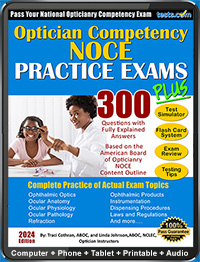To become a professional optometrist, optometry students must pass a series of exams administered by the National Board of Examiners in Optometry (NBEO). The primary NBEO exam includes three parts: Applied Basic Science (I), Patient Assessment and Management (II) and Clinical Skills (III). Some practitioners may also opt to take the Advanced Competency in Medical Optometry exam (ACMO).
The National Board restructured its exams through 2009-2010. The class of 2009 was the last class to take exams in the previous format. The restructured Part I was last offered in 2008. Candidates who have taken exams prior to 2009 and wish to retake will be offered exams in the new, restructured format. Both formats are considered to be the equivalent of each other.
Part I – Applied Basic Science (ABS)
Part I asks 500 questions on epidemiology, patient history, symptoms, pathophysiology, clinical testing and diagnosis. This exam is conducted in four three-and-a-half hour sessions. Each session includes 125 questions.
Part I is administered to students in the spring of their third academic year. Students have three opportunities to take Part I before graduating. The exam is offered in August and December of each year.
Part II – Patient Assessment and Management (PAM)
Patient Assessment and Management is a written exam that involves 30 patient-centered scenarios. PAM is offered in two three-and-a-half hour sessions. Candidates are presented with patient history and clinical data with a visual, followed by multiple choice questions about the case. Questions may involve basic scientific principles, public health issues, law, ethics or treatment and management of ocular diseases (TMOD). Students will be asked about diagnosis, assessment, treatment or all three. Cases will center either on disease or trauma, or refractive or functional conditions.
Until April 2009, NBEO offered a separate Treatment and Management of Ocular Disease exam (TMOD), but because Part II’s section on Ocular Disease and Trauma has been used as an acceptable substitute for the separate exam, TMOD was phased out. Most states accept the TMOD subscore Part II generates, but some states still require a separate TMOD score. Students wishing to practice in such states may declare themselves TMOD-only test candidates for the day-long Part II PAM to receive a score acceptable to their home state.
Part II is administered to students in their final year of optometry school. Students have two opportunities to take the exam prior to graduation. The exam is offered every April and December.
Part III – Clinical Skills
Part III includes a four-station Clinical Skills Examination. The previous Part III exam included the Clinical Skills Examination and Patient Assessment and Management Exam (now Part II). The last administration of the previous test is in August 2009. In April 2010, the new Part III exam will be implemented.
During the Clinical Skills Examination, candidates examine four patients, each for 30 minutes at different stations, and are evaluated on a total of 19 clinical skills throughout:
- Station 1: Case History and Patient Communication; Near Cover Test; Binocular Extraocular Muscle Motility Evaluation; Blood Pressure Measurement; and Ophthalmic Lens Evaluation
- Station 2: Pupil Testing; Biomicroscopy; Goldmann Applanation Tonometry; Gonioscopy; Collagen Implant Insertion and Removal; and Ocular Disease Management: Patient Education
- Station 3: Retinoscopy; Distance Subjective Refraction; Heterophoria and Vergence Testing at Distance; and Accommodation Testing
- Station 4: Binocular Indirect Ophthalmoscopy; Dilated Biomicroscopy and Non-Contact Fundus Lens Evaluation; Soft Contact Lens Insertion, Evaluation and Removal; and Gas Permeable Contact Lens Insertion, Evaluation and Removal
Part III exams are offered in April and August to students in their last year of optometry school. Students have just one opportunity to complete the exam prior to graduation.
Advanced Competency in Medical Optometry Exam
The Advanced Competency in Medical Optometry (ACMO) exam is designed for doctors of optometry who have completed a residency within the Veterans Affairs (VA) healthcare system. It is an optional exam that gives doctors of optometry similar professional recognition and status that other VA professionals achieve.
The exam includes 160 questions related to 40 individual patient cases. Each case is followed by four questions on diagnosis, diagnosis follow up, treatment and treatment follow up.
Exam candidates must either:
- Complete an accredited VA residency program
- Complete an accredited residency program and be involved in the education and training of VA optometry residents
- Actively train and educate VA optometry residents
- Provide optometric care to VA patients
In addition to meeting one of the above, candidates must also:
-
Have active licensure as of March 8, 2008
-
Have no active state board investigations or previous or pending licensure sanctions
The exam is offered once yearly in June in a four-and-a-half hour session.
State Licensure Requirements
In addition to state-specific requirements,
- Alabama, California, Michigan, Nevada, Oklahoma, Puerto Rico and Wisconsin require NBEO Parts I, II and III.
- Florida and North Carolina require NBEO Parts I and II and TMOD.
- Louisiana and the Virgin Islands require NBEO Parts I and II.
All four exams – NBEO Parts I, II and III and the TMOD – are required by the remaining 41 states and the District of Columbia.
Individual jurisdiction exam requirements vary. California, Georgia, Indiana, Minnesota, Missouri, Nebraska, Nevada, North Dakota, Oregon, South Dakota and Texas administer a test on state law. Other jurisdictions – Connecticut, Delaware, District of Columbia, Hawaii, Illinois, Iowa, Montana, New Jersey, New York, Pennsylvania, Rhode Island, Vermont and Virginia – do not have their own tests. Every other jurisdiction requires some combination of written tests, practical exams, pharmacology tests, interviews and oral examinations. Optometry candidates should verify licensure requirements with their state board before pursuing any optometry test.
Registration and Fees
Exam candidates can register online through NBEO. Students will be asked to create an account to start the registration process and will be required to provide a credit card number to cover exam fees.
Exam fees are currently as follows:
-
Part I - $625
-
Part II - $625
-
Part III - $625
-
TMOD - $450
-
ACMO - $780
-
State Law - $70
Note that when the restructured exams are fully in place, fees may change.
Students may consult with their school’s National Board of Examiners in Optometry liaison with registration questions.
Test Locations
Written exams (Part I and II) are offered at test centers in 18 US cities as well as in San Juan, Puerto Rico, each in close proximity to one of the 19 Association of Schools and Colleges of Optometry-accredited optometry programs.
The Clinical Skills Examination is offered during three or four weekends each year in cities close to each optometry school.
The ACMO examination is offered on its June test date at more than 200 Pearson Vue test centers nationwide.
Scores
Parts I, II and III are scored in the 100-900 range. The pass-fail cutoff score is 300. All other sections are scored from 0-99. 75 is the pass-fail cutoff score.
Are you starting to prepare for optometry exams and need some study aids? Check out our Directory of Optometry Tests to find the perfect program to help ace your exams.
Sources: National Board of Examiners in Optometry, optometry.org; Optometry.org, optometry.org/pdf/TMOD_phaseout.pdf





